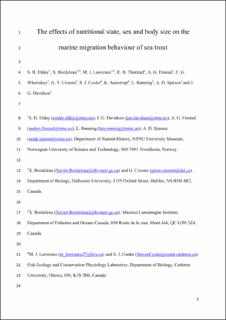| dc.description.abstract | The sea trout (anadromous brown trout Salmo trutta) displays extensive among-individual variation in marine migration behaviour. We studied the migration behaviour of 286 sea trout (27-89 cm) tagged with acoustic transmitters in the spring, in 7 populations located in 2 distinct marine fjord systems in Norway. We examined whether individual nutritional state, sex and body size influenced marine migration behaviour in terms of (1) the decision to migrate to the sea or remain resident in freshwater and/or estuarine habitats, (2) seasonal timing of sea entry, (3) duration of the marine residency and (4) migration distance at sea from the home river. Most sea trout were in a poor nutritional state in the spring prior to migration. Sea trout with low body condition factors and low plasma triglyceride levels were more likely to migrate to sea, and low triglyceride levels were also associated with earlier sea entry. Poor body condition also increased the probability of individuals remaining at sea longer and migrating further offshore compared to fish in better condition. Females were more likely to migrate to the sea than males. Larger fish were also more likely to migrate to the sea instead of remaining in freshwater and estuaries, and dispersed over greater distances from the river than smaller fish. In conclusion, this study documented general trends across multiple populations and showed that nutritional state, sex and body size influence important aspects of the marine migration behaviour of sea trout. | en_US |
